Houseplants are an excellent way to bring a touch of the great outdoors into your home or office space. Not only do they have the ability to purify the air, but they also have a calming and relaxing effect on the mind and body. If you’re looking to add a unique and visually striking element to your indoor garden, then you should definitely consider houseplants with red and green leaves. These plants are not only aesthetically pleasing, but they also offer a plethora of benefits, ranging from improving air quality to enhancing your overall mood.
In this article, we’ll delve into some of the best houseplants with red and green leaves that are both easy to care for and will add a vibrant burst of color to any room. So, whether you’re a seasoned plant enthusiast or a beginner looking to add some greenery to your space, you’re sure to find something that catches your eye. Get ready to explore the world of red and green houseplants and discover the perfect addition to your indoor garden!
Benefits of Having Houseplants with Red and Green Leaves
Houseplants are a fantastic way to bring some greenery into your home, but did you know that they also offer a plethora of health benefits? And when it comes to houseplants with red and green leaves, the benefits are even more impressive! Here are just a few of the many advantages of having houseplants with red and green leaves:
1. Improved air quality: Houseplants are renowned for their ability to purify the air by removing harmful toxins and pollutants. But did you know that plants with red and green leaves, such as the Red Aglaonema or the Red-Edged Dracaena, are particularly effective at removing formaldehyde, benzene, and other harmful chemicals from the air? It’s true!
2. Reduced stress and anxiety: Numerous studies have shown that being around plants can help reduce stress and anxiety levels. And the vibrant colors of red and green leaves can have a calming effect on the mind, promoting relaxation and tranquility.
3. Increased productivity: Having plants in your home or office can help boost productivity and creativity. And when it comes to plants with red and green leaves, they can stimulate the brain and improve focus, making it easier to concentrate on tasks and get things done.
4. Improved mood: The colors of red and green are associated with positive emotions such as happiness, joy, and energy. So it’s no surprise that having houseplants with red and green leaves can help improve your mood and overall well-being.
5. Aesthetic appeal: Houseplants with red and green leaves are not only beneficial for your health, but they also add a pop of color and visual interest to your home decor. They can be used as a focal point in a room or as a complement to other decor elements, making them a versatile and stylish addition to any space.
Houseplants with red and green leaves are a fantastic way to improve your health and well-being while also adding some color and visual interest to your home or office. So why not give them a try and see the benefits for yourself?
Factors to Consider When Choosing Houseplants with Red and Green Leaves
When it comes to selecting houseplants with red and green leaves, there are a plethora of factors to take into account. These factors are crucial in ensuring that you choose the best plants that will flourish in your home and add a vibrant pop of color to your space.
First, lighting is a key factor to consider. The amount of light your houseplant requires is essential to its growth and overall health. Plants with red and green leaves typically require bright, indirect light. It is important to place your plant near a window that receives plenty of sunlight, but be sure to avoid direct sunlight as it can scorch the leaves.
Second, watering is another important factor to consider. Different plants have varying watering needs, so it is crucial to research the specific requirements of the plants you are interested in. Generally, plants with red and green leaves prefer to be kept moist but not waterlogged. It is important to water your plant when the top inch of soil feels dry to the touch.
Third, humidity is a factor that cannot be overlooked. Some houseplants with red and green leaves thrive in high humidity environments. If your home is dry, consider placing a humidifier near your plant or misting it regularly to keep the leaves from drying out.
Fourth, size is an important consideration. It is crucial to consider the size of the plant you want to bring into your home. Some houseplants with red and green leaves can grow quite large, while others are more compact. It is important to choose a plant that will fit comfortably in your space.
Finally, maintenance is a crucial factor to consider. It is important to choose a plant that fits your lifestyle and schedule. Some plants require more attention than others, so it is important to choose a plant that you can maintain.
By taking these factors into consideration, you can choose the best houseplants with red and green leaves that will thrive in your home and add a beautiful touch of color to your space.
Top 5 Houseplants with Red and Green Leaves
Houseplants are a fantastic way to bring some vibrancy and vitality into your living space. If you’re seeking a plant that will truly make a statement, why not opt for one with red and green leaves? Here are the top 5 houseplants with red and green leaves that are sure to catch your eye:
Red Veined Nerve Plant
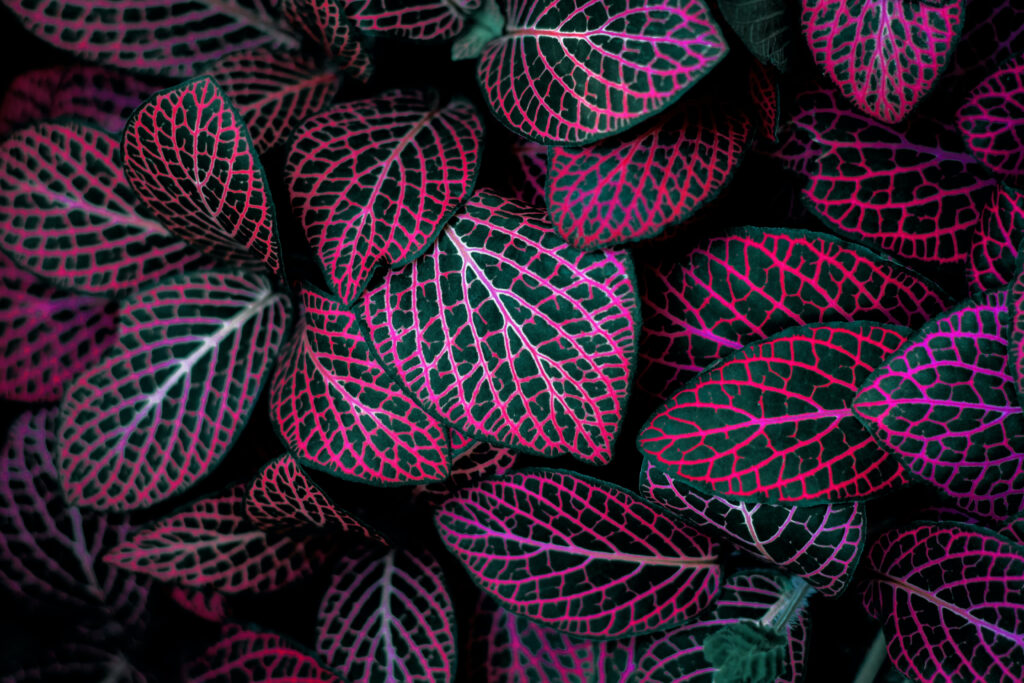
The red veined nerve plant is a small and delicate plant with dark green leaves and striking red veins. This plant is perfect for adding some color to a small space, such as a desk or bookshelf. It’s a low-maintenance option that can grow up to 6 inches tall.
These are the top 5 houseplants with red and green leaves that are sure to add some pizzazz to your living space. Whether you’re seeking a towering and commanding plant or a small and delicate one, there’s a plant on this list that will suit your needs. These plants are easy to care for and will bring some much-needed color and vitality into your home.
Calathea
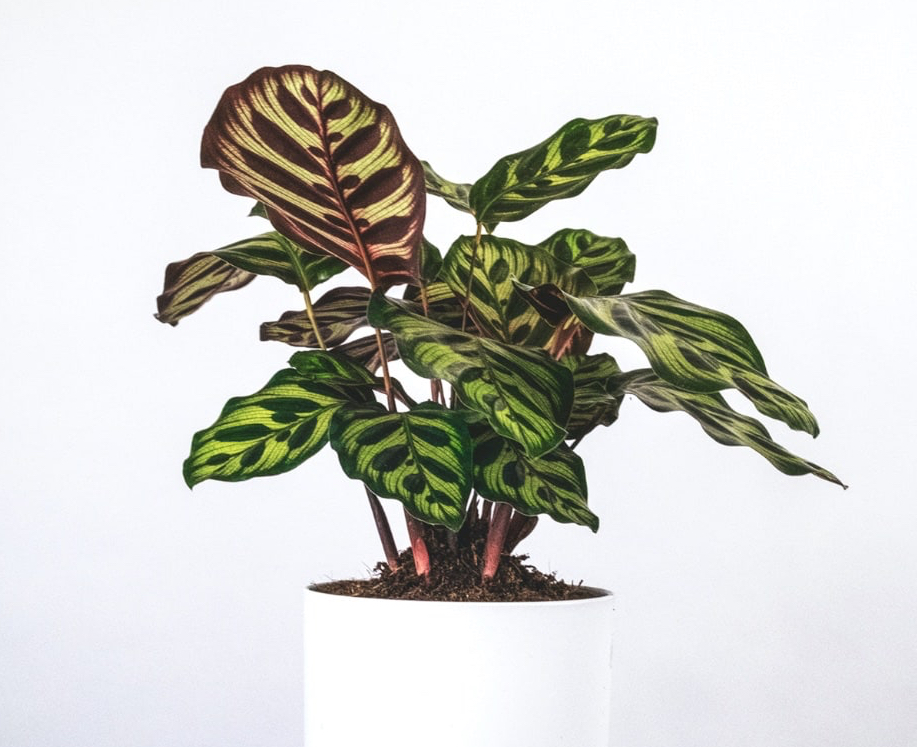
Calathea, a popular houseplant, is renowned for its stunning foliage. The plant boasts large, oval-shaped leaves with intricate patterns of red and green, making it a perfect addition to any home decor.
Thriving in low to medium light conditions, Calathea is a low-maintenance plant that prefers moist soil. Regular watering and occasional misting to increase humidity levels are essential for its growth.
One of the unique features of Calathea is its ability to move its leaves. The plant’s leaves move up and down in response to changes in light and temperature, giving it the nickname “prayer plant.”
Calathea is not only a beautiful plant but also has air-purifying properties. It helps to remove toxins from the air, making it an excellent addition to any home or office.
Overall, Calathea is an excellent choice for those seeking a houseplant with red and green leaves. Its stunning foliage, low-maintenance nature, and air-purifying properties make it a must-have for any plant lover.
Croton
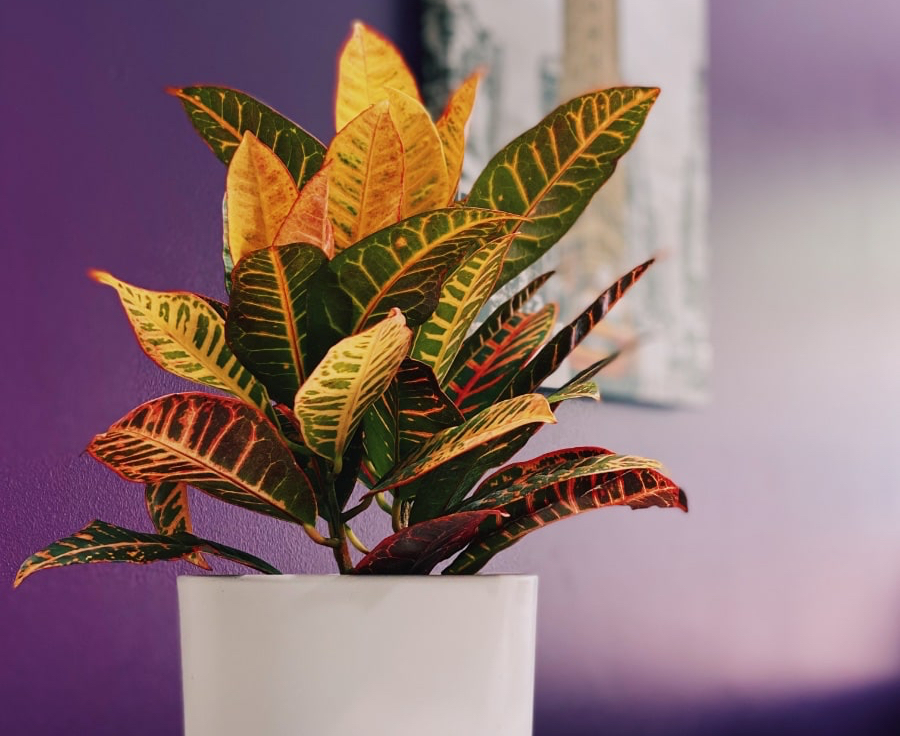
The Croton plant is a popular houseplant that is widely known for its vibrant and colorful foliage. Its leaves come in a variety of colors, including red, green, yellow, and orange, making it a perfect addition to any home decor. But what makes this plant truly unique is its ability to change color depending on the amount of light it receives. When exposed to bright sunlight, the leaves turn a deep shade of red, while in low light conditions, the leaves turn green.
Caring for a Croton plant is easy and requires minimal maintenance. It thrives in bright, indirect sunlight and prefers to be kept in well-draining soil. However, it is important to keep the soil moist but not waterlogged, as overwatering can lead to root rot.
Aside from its aesthetic appeal, the Croton plant is also known for its air-purifying properties. It can remove harmful toxins from the air, making it a great addition to any home or office.
Overall, the Croton plant is a beautiful and easy-to-care-for houseplant that adds a burst of color to any room. Its red and green leaves make it a standout among other houseplants, and its air-purifying properties make it a healthy addition to any living space.
Red Aglaonema
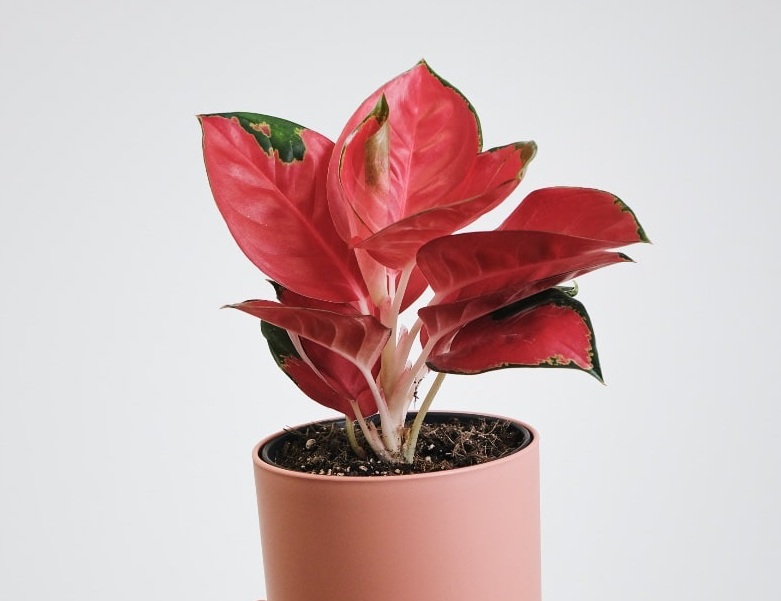
The Red Aglaonema, a member of the Araceae family, is a popular houseplant that boasts stunning red and green leaves. Hailing from Southeast Asia, this plant is also known as the Chinese Evergreen and is a fantastic option for those looking to add a pop of color to their indoor space.
The leaves of the Red Aglaonema are a deep green hue, with bright red veins that run through them, creating a mesmerizing visual effect. This plant can grow up to 3 feet tall and is relatively easy to care for, preferring bright, indirect light and requiring watering only when the top inch of soil is dry.
One of the most significant benefits of the Red Aglaonema is its air-purifying properties. This plant can effectively remove toxins such as benzene, formaldehyde, and trichloroethylene from the air, making it an excellent choice for those who suffer from allergies or asthma.
Moreover, the Red Aglaonema is a low-maintenance plant that can thrive in a variety of conditions. Its slow-growing nature means that it won’t outgrow its space quickly, making it an ideal choice for those who want a long-lasting, visually appealing houseplant.
The Red Aglaonema is a stunning houseplant that is easy to care for and adds a touch of color to any indoor space. Its air-purifying properties and low-maintenance nature make it an excellent choice for those looking to improve the air quality in their home while enjoying the beauty of nature.
Red-Edged Dracaena
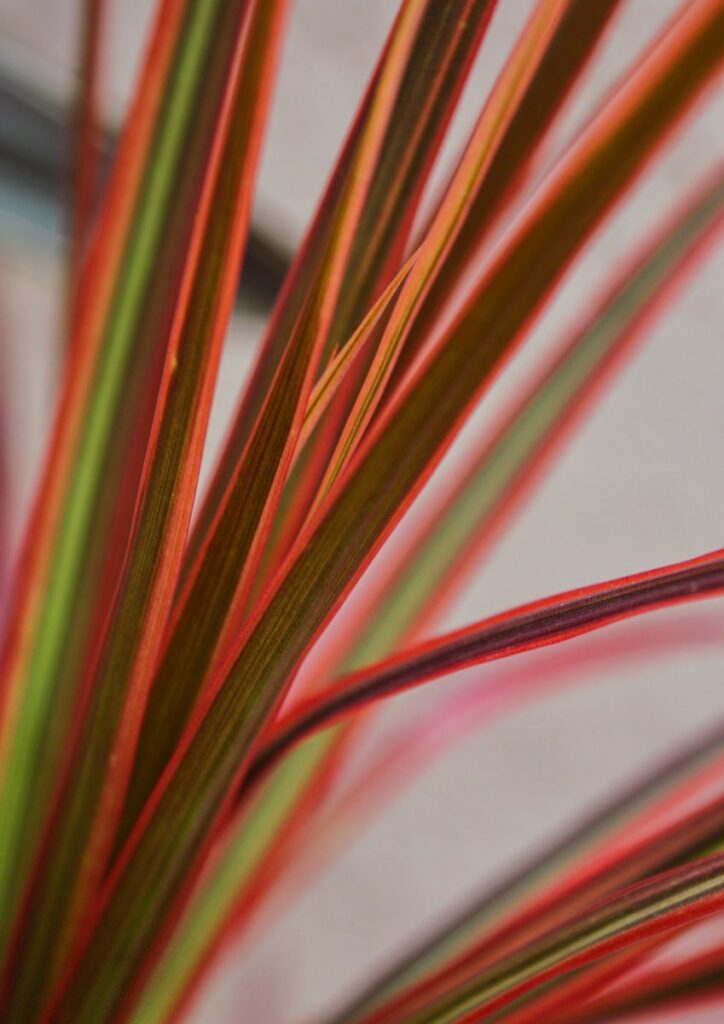
The Red-Edged Dracaena, also known as the Madagascar Dragon Tree, is a popular houseplant that boasts striking red and green leaves. This slow-growing plant can reach up to 6 feet in height, making it a statement piece in any room.
The leaves of the Red-Edged Dracaena are long and narrow, with a deep green color and a bright red edge that becomes more prominent as the plant matures. Additionally, the plant produces small white flowers that bloom in clusters, adding to its visual appeal.
Despite its stunning appearance, the Red-Edged Dracaena is a low-maintenance plant that is easy to care for. It prefers bright, indirect light but can tolerate some shade. Furthermore, it thrives in well-draining soil and should be watered only when the top inch of soil is dry to the touch.
One of the most significant benefits of the Red-Edged Dracaena is its ability to purify the air. This plant can remove harmful toxins such as formaldehyde, benzene, and trichloroethylene from the air, making it an excellent addition to any home or office.
The Red-Edged Dracaena is a beautiful and easy-to-care-for houseplant that adds a pop of color to any room. Its air-purifying properties make it a great choice for those looking to improve the air quality in their home.
Red Prayer Plant
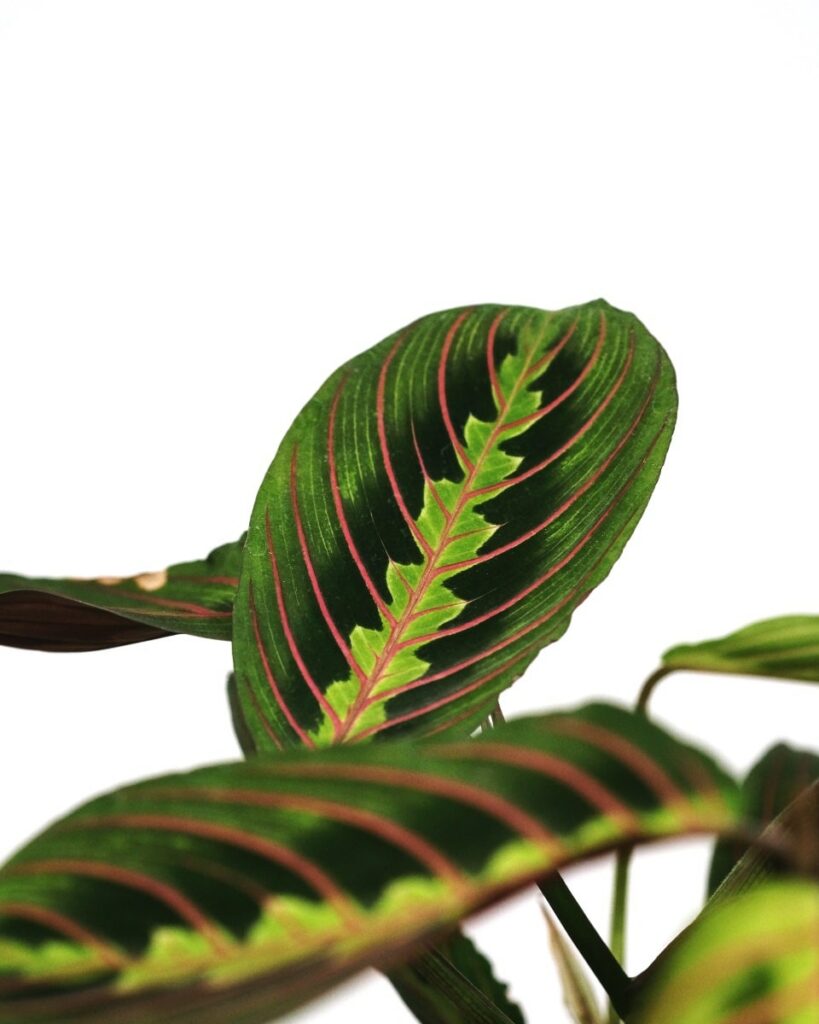
The Red Prayer Plant, also known as Maranta leuconeura erythroneura, is a mesmerizing houseplant that will undoubtedly catch your eye with its vibrant red and green leaves. This plant is native to the tropical rainforests of Brazil and is renowned for its exceptional ability to fold its leaves up at night, resembling hands in prayer.
The Red Prayer Plant’s leaves are oval-shaped and have a dark green hue with bright red veins running through them, making it a sight to behold. The underside of the leaves is a deep maroon color, adding to its striking appearance. This plant can grow up to 12 inches tall and 18 inches wide, making it a great choice for a tabletop or as a hanging plant.
One of the best things about the Red Prayer Plant is that it is relatively easy to care for. It prefers bright, indirect light and well-draining soil. It also likes to be kept consistently moist, but not waterlogged. It is important to avoid letting the soil dry out completely, as this can cause the leaves to wilt and drop.
The Red Prayer Plant is not only beautiful but also has air-purifying qualities, making it a great addition to any home. It is known to remove toxins such as formaldehyde and benzene from the air, improving the overall air quality in your home.
Overall, the Red Prayer Plant is a stunning and easy-to-care-for houseplant that will add a touch of color and elegance to any room. Its unique ability to fold its leaves up at night is a fascinating feature that will surely impress your guests. So, why not bring a piece of the tropical rainforest into your home with the Red Prayer Plant?
Care Tips for Houseplants with Red and Green Leaves
Houseplants with red and green leaves are a stunning sight to behold in any abode. However, their maintenance requires a certain level of expertise to ensure their vibrant hues and overall well-being. Here are some tips to keep in mind:
1. Lighting: The majority of houseplants with red and green leaves necessitate bright, indirect light. Direct sunlight can scorch the leaves, while insufficient light can cause the colors to fade. Therefore, it is imperative to place your plants near a window that receives bright, indirect light for at least six hours a day.
2. Watering: Overwatering is a common mistake when it comes to caring for houseplants. It is crucial to water your plants only when the top inch of soil is dry to the touch. Water thoroughly, allowing excess water to drain out of the bottom of the pot. Avoid letting your plants sit in standing water, as this can lead to root rot.
3. Humidity: Many houseplants with red and green leaves prefer high humidity levels. You can increase humidity by placing a tray of water near your plants or by using a humidifier. Misting your plants with water can also help, but be careful not to mist too often as this can lead to fungal growth.
4. Fertilizing: Houseplants with red and green leaves benefit from regular fertilization. Use a balanced, water-soluble fertilizer every two to four weeks during the growing season (spring and summer). Reduce fertilization during the winter months when growth slows down.
5. Pruning: Regular pruning can help keep your plants looking their best. Remove any dead or yellowing leaves, as well as any stems that are growing in the wrong direction. You can also pinch back the tips of your plants to encourage bushier growth.
By following these care tips, you can enjoy the beauty of your houseplants with red and green leaves for years to come. However, it is important to remember that each plant has its unique needs, so always check the specific care requirements for your individual plants.
Conclusion and Final Thoughts on Houseplants with Red and Green Leaves
When it comes to sprucing up your indoor space, houseplants with red and green leaves are a fantastic choice. Not only do they add a vibrant burst of color, but they also come with a plethora of health benefits that can help improve air quality and reduce stress levels.
But before you go out and buy just any old plant, it’s important to consider a few key factors. Lighting, watering needs, and space requirements are all crucial elements to keep in mind when selecting the perfect plant for your space.
Luckily, there are plenty of options to choose from when it comes to red and green houseplants. The Red Aglaonema, Croton, and Red-Edged Dracaena are all excellent choices that offer a unique burst of color and texture.
By incorporating these stunning and beneficial plants into your home or office, you can not only enhance the aesthetic appeal of your space but also promote a healthier environment
Frequently Asked Questions
What are some benefits of having houseplants with red and green leaves?
Houseplants with red and green leaves not only add a pop of color to your home decor, but they also have several benefits. They can improve air quality by removing toxins from the air, increase humidity levels, and reduce stress levels.
What are some popular houseplants with red and green leaves?
Some popular houseplants with red and green leaves include the Red Aglaonema, Red Prayer Plant, Red-Edged Dracaena, and the Red Philodendron. These plants are not only visually appealing but also easy to care for.
How do I care for houseplants with red and green leaves?
Most houseplants with red and green leaves require bright, indirect light and well-draining soil. They should be watered when the top inch of soil is dry and fertilized every 2-4 weeks during the growing season. It’s important to also keep an eye out for pests and diseases and address them promptly.
Can houseplants with red and green leaves be toxic to pets?
Some houseplants with red and green leaves, such as the Red-Edged Dracaena and the Red Philodendron, can be toxic to pets if ingested. It’s important to research the toxicity of a plant before bringing it into a home with pets and to keep it out of reach.
Where can I buy houseplants with red and green leaves?
Houseplants with red and green leaves can be found at most garden centers, nurseries, and even online retailers. It’s important to purchase plants from a reputable source and to inspect them for any signs of pests or diseases before bringing them home.
